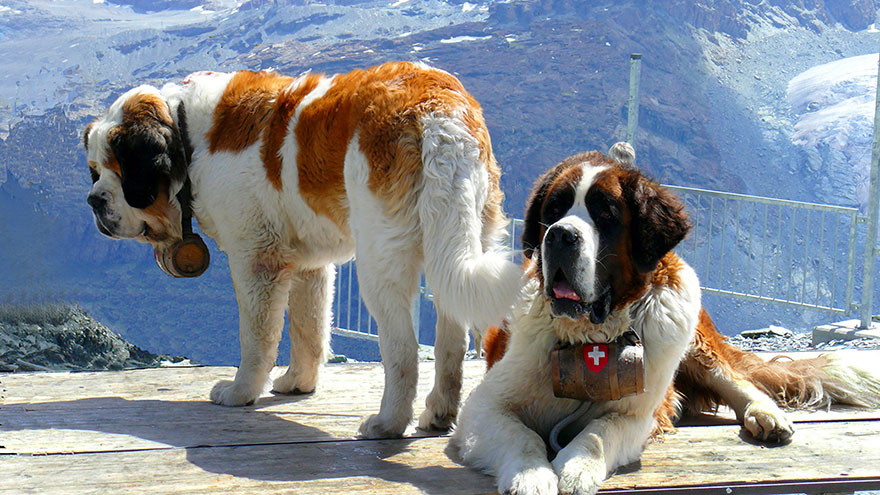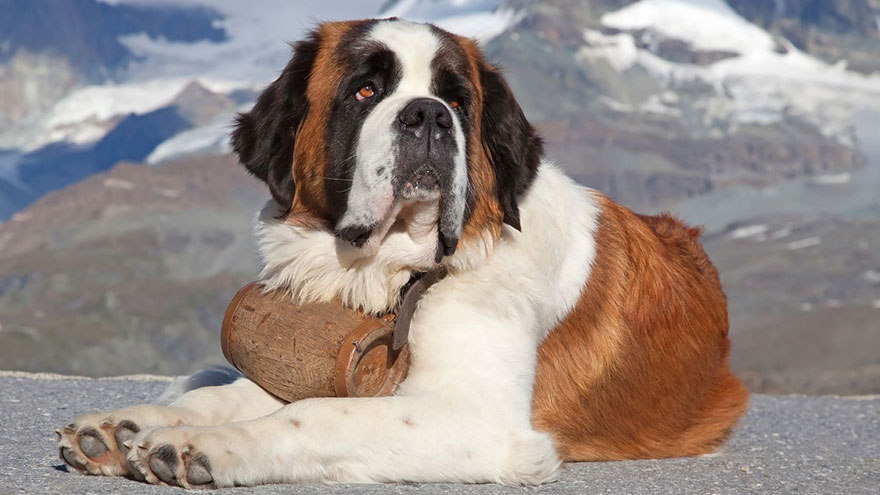Saint Bernard Breed Information
The Saint Bernard is originally from Switzerland where it was a favorite breed during the 17th century to the monks of Hospice du Grand St. Bernard, thus the name. Although it is uncertain, most experts believe this breed came from Asiatic dogs, which were from the Roman armies and descendents of the giant Mastiff.
Although the Saint Bernard was first used for protection and as a watchdog, today they make wonderful pets while also being used for rescue.
Used often for protection and patrolling the snowy mountains in search of lost or stranded people, the Saint Bernard breed continues to serve this purpose. Even currently, this particular breed is great for finding people buried in avalanches and due to the thick coat, can handle cold weather without any problem.
Additionally, the Saint Bernard is an excellent swimmer, capable of towing people and even small boats back into shore.
Saint Bernard Temperament
You will find the Saint Bernard to be extremely strong and muscular, as well as intelligent. Bred as a working dog, he is always eager to help around with chores. For this reason, some countries use this breed for pulling carts. Regardless of the purpose, the Saint Bernard is extremely gentle and dependable.
If you want an excellent family pet or companion dog, it is hard to beat the temperament of the St. Bernard. Without doubt, this breed offers one of the kindest, most gentle, and easiest going personalities you will find, being a great choice for people with children.

Saint Bernard Size and Color
The size of the Saint Bernard varies between male and female. Typically, the male dog will measure between 28 and 30 inches at the withers while the female is slightly shorter, between 26 and 28 inches. For weight, the male often reaches 150 to 180 pounds and the female is still quite large, generally weighing from 120 to 140 pounds.
Remember, the coat is thick and available in two varieties. First, is the original, short-hard version of the breed, which has a smooth, dense, and touch coat. The second variety is the longhaired version, which has medium-length hair that can be straight or somewhat wavy.
For color, you usually see white with red markings or red with white markings. Either way, the dog should have white markings on the feet, chest, head, neck, and the tip of the tail.

Saint Bernard Feeding and Grooming Requirements
If you plan to purchase a Saint Bernard, be prepared to spend good money on food. Although you can work with this breed to eat similar to any large dog breed, these dogs are massive in size and physical so they have a fierce appetite.
The key is to provide quality food, which could be in the form of commercial food or fresh food. In addition, you might want to talk to your veterinarian about the need for supplements, which might be needed. Because of the massive coat, the Saint Bernard does shed. Now, the good news is that shedding is done twice a year, in the spring and then again, the fall. However, unless shedding during these two seasons, you will have little problem. Even so, you want to brush your Saint Bernard daily.
For bathing, we recommend you use a grooming table or bathe your Saint Bernard outdoors. The key is to choose shampoo that will help whiten the coat. Something such as Clairol Shimmer Lights, All Systems whitening shampoo, Show Paste shampoo, and Jardine’s Whitening shampoo are best.
Just make sure you rinse well and allow the dog to air dry, which generally takes a while. In addition, this breed is known to drool and often prefers living outside in cooler climates.

Read More About Saint Bernard
- Saint Bernard : 10 Most Common Questions
- Saint Bernard Training Guide
- Saint Bernard Health Guide
- Owning a Saint Bernard : Breeder Recommendations

